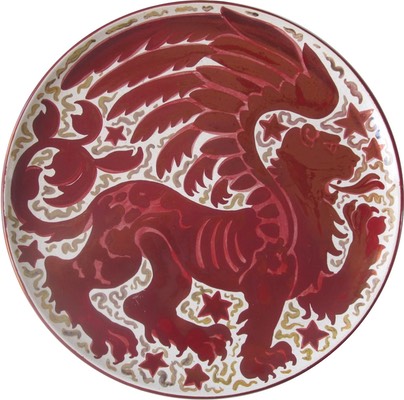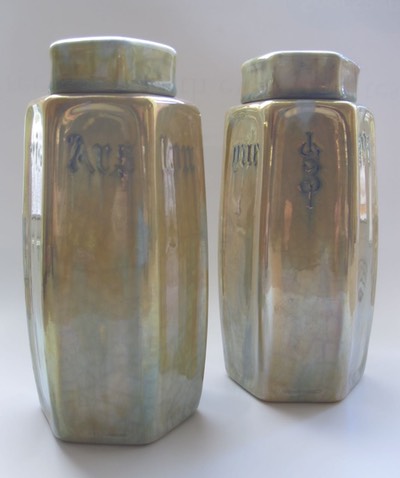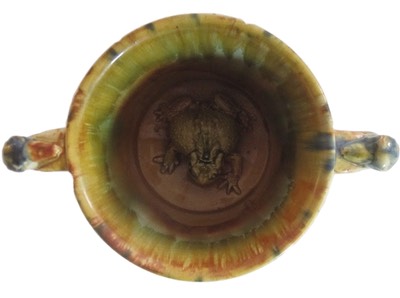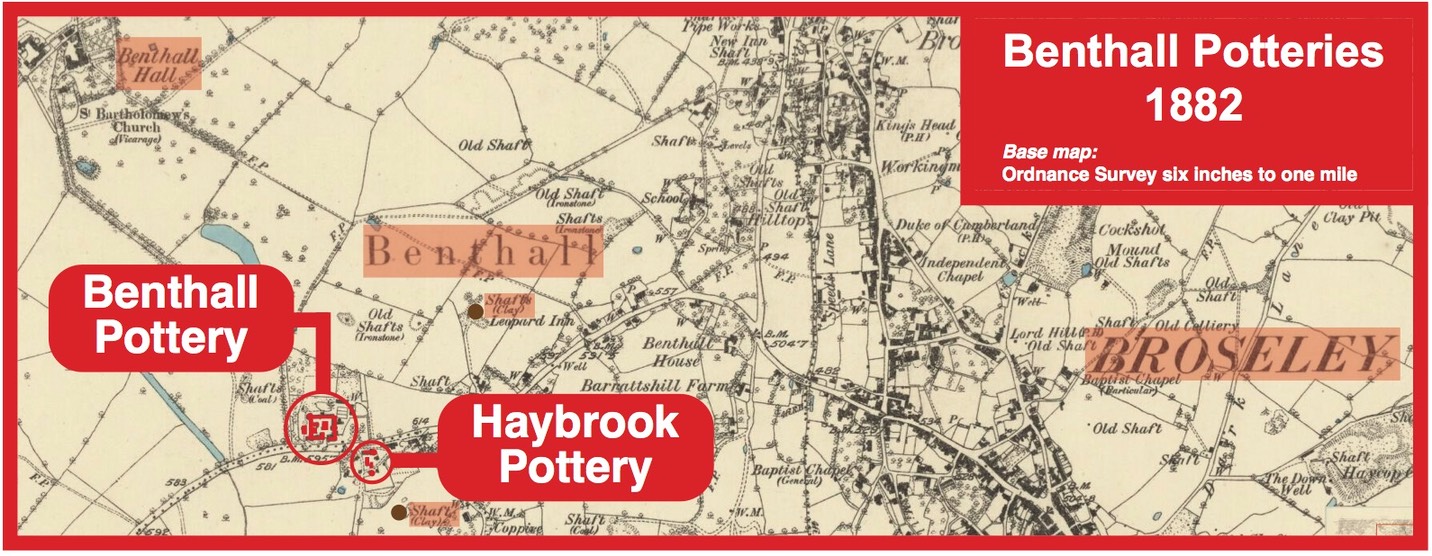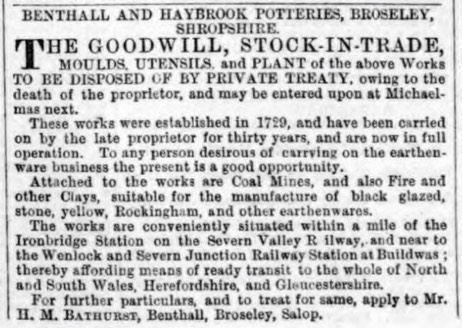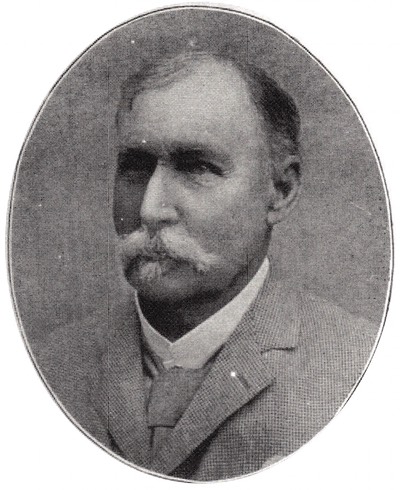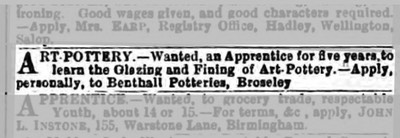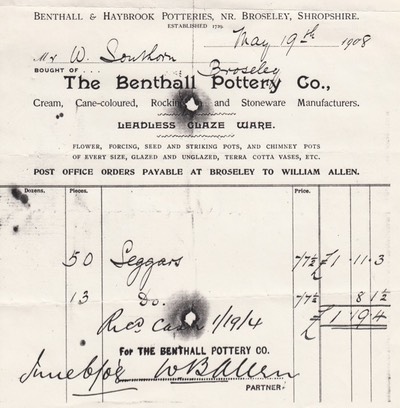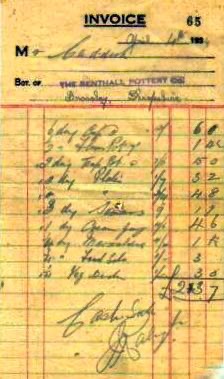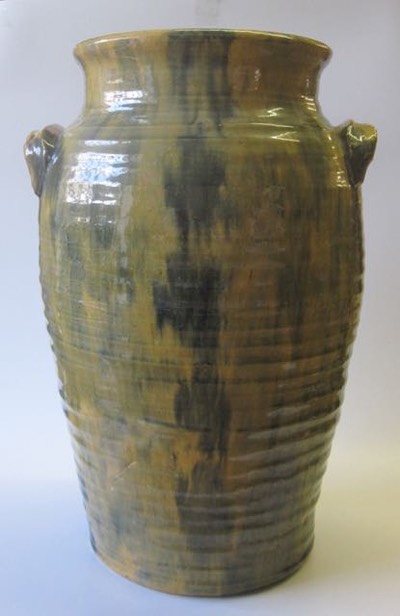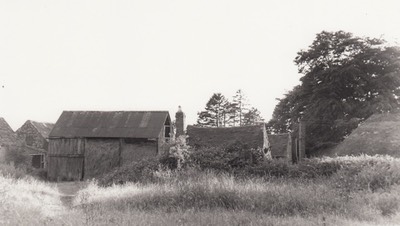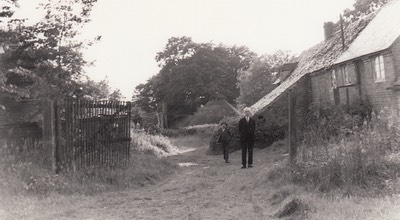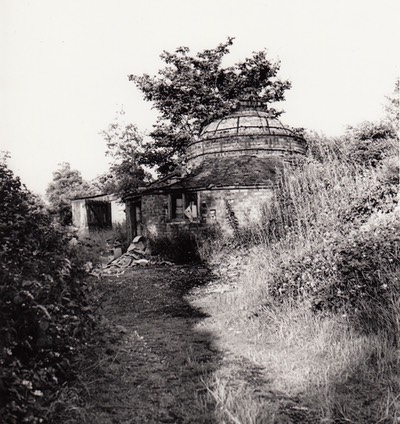East Shropshire and the ceramics industry
Shropshire is a county in the West Midlands region of England. The eastern area of the county is rich in coal and clay, and many centres of ceramic production were established here to exploit these reserves. They include:
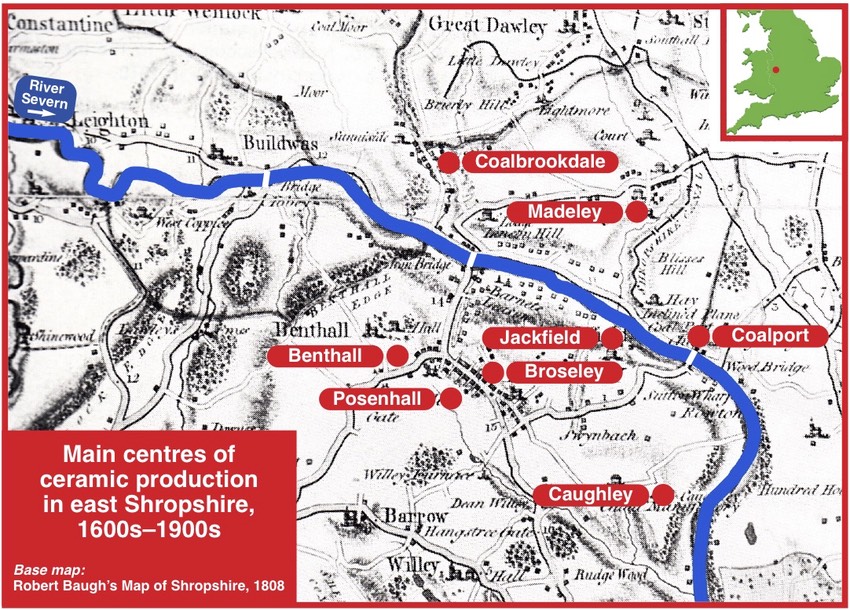
- 1600s–1800s: slipware, white and brown salt-glazed stoneware, black-glazed "Jackfield ware" and everyday earthenwares made at Jackfield, Benthall and Posenhall.
- 1600s–1957: clay tobacco pipes made at Broseley.
- 1772–1926: porcelain made at Caughley (say: carf-lee), Madeley and Coalport.
- c.1795–c.1800: fine earthenwares, creamware and black-basalt ware made at Coalport.
- 1852–1969: mass-produced decorative floor and wall tiles made at Benthall, Jackfield and Broseley.
- c.1860s–c.1890s: earthenware and terracotta made at Coalbrookdale.
- c.1880s–1930s: decorative art pottery made at Benthall and Jackfield.
The art pottery movement in Shropshire
The term "art pottery" is used to describe wares produced in Britain over a period of about 60 years, from roughly the 1870s to the 1930s. It was a style of pottery that reflected contemporary artistic taste and which owed its origins to an artistic movement that changed attitudes to art, design and industry.
Referred to as the Arts and Crafts movement, it was a conscious effort to move away from the constraints of mass-produced machine-made wares which, by the mid-nineteenth century, dominated the market and stifled individuality and creative expression.
Art pottery was a product of the Arts and Crafts movement. It was largely hand-made and decorative, and was made by individual artist-potters and by established potteries keen to expand their ranges as demand for the new style increased. With a well-established ceramics industry, it was no surprise that art pottery was made by the potteries of east Shropshire.
At Jackfield, the tile manufacturers Maw & Company, and Craven Dunnill, produced small quantities of art pottery (see images, right), but the greatest and most varied output came from Benthall where, from 1880, the Benthall Pottery Company produced a range of decorative pottery.
Unmatched pair of Craven Dunnill gold lustre art pottery hexagonal lidded vases, both with relief inscriptions in Latin, one dated 1931.
The vase to the left is inscribed "Ars longa vi brevis” (Art is long, life is short), the one to the right “Vive valeque 1931” (Live and be well 1931).
Private collection
The Benthall Potteries
In the 1800s, several potteries existed in the hamlet of Benthall, two of which were opposite each other on Benthall Lane (the B4375, Broseley to Much Wenlock road). Benthall Pottery was on the north side of Benthall Lane, at the junction with The Avenue leading to Benthall Hall, and the older Haybrook Pottery was south of the lane.
Writing in 1879, Shropshire historian John Randall (1810–1910) said of the Haybrook Pottery that it was "known as the 'Mug-house', from the number of drinking mugs made there”.
A sale notice of the two potteries in the Shrewsbury Chronicle and the Staffordshire Advertiser (16 and 17 May 1862, respectively) records they were established in 1729 (see image, below). This date is presumed to refer to Haybrook Pottery, as the date of Benthall Pottery’s establishment is traditionally given as 1772, when the works is said to have been founded by John Thursfield II who relocated from an existing pottery at nearby Jackfield.
During the eighteenth and first half of the nineteenth century, Benthall and Haybrook potteries operated independently of each other, changing hands several times.
The two potteries were eventually merged into one business, c.1832, under the ownership of Edwin Bathurst (1802–1861). The merger date is deduced from an advertisement in Eddowes’s Shrewsbury Journal, 11 July 1855, in which Bathurst refers to “the patronage he has received for the last twenty-three years" (see image, below). From then on they were known as the Benthall & Haybrook Potteries.
This advertisement is useful not only for providing a date of the formation of the Benthall & Haybrook Potteries, but in listing the range of traditional country pottery produced in the 1850s.
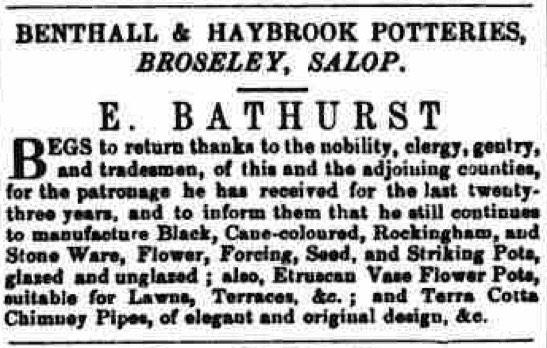
A remarkable incident occurred in September 1855, when Abel Ward was digging clay for use at the pottery. At a depth of five feet he “came upon a toad embedded in the solid clay … the block was carefully cut out with the spade without disturbing the animal, who still continues to inhabit his prison-house, and may be inspected by any of the curious” (Eddowes’s Shrewsbury Journal, 26 September 1855, and widely reported in the regional press, e.g. Worcester Journal, Staffordshire Sentinel, and others).
Among the curious was John Randall, who gave a lecture at the Shrewsbury Mechanics’ Institute in April 1857 “On the Exhumed Toad of the Benthall Potteries”. The toad was "exhibited during the lecture,” though what state it was in is not recorded (Wellington Journal and Shropshire Advertiser, 18 April 1857).
Many years later, c.1890s, the Benthall Pottery produced a large two-handled Salopian Art Pottery loving cup with a carefully modelled toad sitting at the bottom – a practical joke on an unsuspecting drinker but, perhaps, a memory of the Benthall “toad in the hole" found entombed in clay (see image, right). Two examples of this cup are known.
Coal for firing the company’s kilns was also dug locally, and the pottery owned its own mine (Benthall Colliery).
A tragedy occurred at the mine in April 1860, when “chokedamp" overcame two of the pottery’s workers. William Jones, a boy, suffocated and died, and John Jones made a slow recovery “on being brought to the mouth of the pit” (Wolverhampton Chronicle, 4 April 1860).
The census of April 1861 records that Edwin Bathurst, earthenware manufacturer, was resident at the Benthall Pottery, where he employed 27 men and 7 boys.
Edwin Bathurst died 12 November 1861, and just six months later, in May 1862, the Benthall & Haybrook Potteries were sold by his eldest son, Henry Martyn Bathurst (1824–1882).
Benthall Pottery and Salopian Art Pottery
Sale notice of 1862 for the Benthall & Haybrook Potteries, following the death of owner Edwin Bathurst.
The notice records 1729 as the foundation date of the potteries, and that Bathurst had been proprietor for 30 years prior to his death, putting the date of the potteries' merger at c.1832, which corresponds with the date deduced from the 1855 advertisement (see above, left).
Source: Staffordshire Advertiser, 17 May 1862. Image © The British Library Board
The same advertisement was also published in the Shrewsbury Chronicle, 16 May 1862.
The 1862 sale notice (published in the Shrewsbury Chronicle and the Staffordshire Advertiser) describes the potteries as being in "full operation" and offering a "good opportunity" for "any person desirous of carrying on the earthenware business", noting that the local clays besides the works were suitable for the manufacture of "black glazed, stone, yellow, Rockingham, and other earthenwares" – the common pottery of the day.
The buyer was William Allen (1834–1907), a local man from Broseley, who, at the time of buying the business, worked as a brickmaker at his father’s brickworks in Wednesfield, south Staffordshire.
The first known record of William Allen at the Benthall & Haybrook Potteries is in March 1863, when he and a Mr Griffith “gave a dinner to their workpeople at the Haybrook Pottery” (Birmingham Daily Post, 11 March 1863). The dinner was in celebration of the royal wedding of Prince Albert, the Prince of Wales, and Princess Alexandra of Denmark.
Under Allen's management the Benthall & Haybrook Potteries became known as the Benthall Pottery Company, by which name it traded (see invoice, below right). The business continued to produce traditional country pottery for the local market.
At the time of the 1871 census, Allen’s occupation was given as "Potter/Manufacturer", employing 48 staff – 30 men, 11 women and 7 boys.
Allen advertised in local newspapers, and in May and June 1872 he announced to “country gentlemen” that the Benthall Pottery “is prepared to supply fish-hatching troughs suitable for salmon or trout spawn” (Shrewsbury Chronicle, 31 May 1872; 14 June 1872).
Writing in 1877, the Shropshire historian John Randall says of Allen:
“…to the ordinary red and yellow ware, which finds a ready sale in North and South Wales, [he] has added articles of use and ornament in other ways, including forcing pots, garden vases, and various terra cotta articles”.
It’s a glimpse into the coarse wares that were being made at Benthall, but all was about to change for this rural Shropshire pottery.
William Allen (1834–1907), proprietor of the Benthall Pottery Company, under whose management Salopian Art Pottery was first produced, from 1880 onwards.
Image: Cameron Penn: Staffordshire and Shropshire at the Opening of the Twentieth Century: Contemporary Biographies (Brighton, 1907)
In 1880, William Allen took the bold step of diversifying Benthall Pottery’s product range. In a move away from coarse wares he introduced a range of decorative art pottery. It was called “Salopian Art Pottery”, after an ancient name for the county of Shropshire (Salopesberia, abbreviated to Salop). The first record of Salopian Art Pottery is in November 1880, when an advertisement appeared in The Graphic, a weekly national newspaper.
The 1881 census records how the business had grown to a workforce of 55 staff – 35 men, 16 women and 4 boys.
A tantalising reference to early pieces of Salopian Art Pottery is recorded in the Wellington Journal & Shrewsbury News, 24 September 1881, describing the bazaar held at the opening of the Eye, Ear and Throat Hospital, Shrewsbury: “Across the front of the orchestra was a row of specimens of Salopian decorative art in pottery sent from the Benthall Works. Amongst them were some very beautiful vases, with raised flowers after the style of the Sevres china.” This is the earliest known reference to raised work pieces.
Commenting on the same event, Eddowes's Shrewsbury Journal, 28 September 1881, says: "In front of the foliage plants on the orchestra was an interesting collection of specimens of decorative art pottery, obtained from Mr Allen, Benthall Works, and placed in the charge of Mr Edgell. The collection included specimens of Roman amphorae, Grecian beakers, and Etruscan vases, all of which were graceful illustrations of the ceramic art.” A reference to pieces made in the classical style occurs in an 1882 advertisement.
In 1882, Allen registered the company, issuing a single share in his name (The Investors’ Guardian, as reported in the Worcestershire Chronicle, 6 May 1882). The company is presumed to be the Salopian Art Pottery Company (or Salopian Decorative Art Pottery Company) whose name first appears in an advertisement from 1882.
That September, a classified advertisement appeared in the Wellington Journal (30 September 1882) for an apprentice to join the Benthall Potteries for five years to “learn the glazing and firing of art pottery”.
Although no records are known to exist of who the apprentice was, it’s significant that the job was created in 1882 which was clearly a formative year for the company’s diversification into art pottery. Perhaps in recognition of this key year in the company’s history, the earliest dated piece of Salopian Art Pottery bears the date 1882.
Allen clearly had a keen eye on the market, as he launched his Salopian Art Pottery range at a time when the public taste for decorative hand-made pottery was emerging. He also had the clay and, crucially, a skilled local workforce with experience of ceramics.
To reach his intended market of middle-class Victorian home-makers, Allen appointed a succession of London agents (1880–c.1885) and opened a London showroom (1885). Agents were also appointed in towns across Britain.
Benthall Pottery Company invoice dated 19 May 1908, signed by company owner William Beriah Allen, for sale of 63 saggars to the clay tobacco pipe maker W. Southorn, Broseley. The billhead lists the company’s range of country pottery, but there is no mention of its decorative Salopian Art Pottery.
Image: © Ironbridge Gorge Museum
The nineteenth century was the time of international exhibitions, and Salopian Art Pottery was exhibited at them, both at home and abroad. Pieces were displayed at:
- TheMelbourne International Exhibition, Australia (1 October 1880 until 30 April 1881) – the first international exhibition held in the southern hemisphere.
- The International Health Exhibition, London (opened 9 May 1884) – four million people came to see how everyday items and actions could have a bearing on health.
- The Centennial International Exhibition, Melbourne, Australia (1 August 1888 to 31 January 1889) – celebrating 100 years of British settlement; Salopian Art Pottery was displayed on the stand of the Coalbrookdale Company.
The exhibition catalogue of the 1884 International Health Exhibition records six ceramic exhibits described as manufactured by William Allen, Coalbrookdale (that is, the Benthall Pottery Company, and presumed to be Salopian Art Pottery), none of which have been identified:
- Exhibit 190 – Large plaque (designed by Francis Gibbons)
- Exhibit 191 – Yellow glazed plaque (designed by Francis Gibbons)
- Exhibit 233 – Etruscan vase (designed by Henry Williams)
- Exhibit 235 – Large vase (designed by Owen Gibbons)
- Exhibit 241 – Brown and white plate (designed by Henry Williams)
- Exhibit 242 – Plate (designed by Henry Williams)
A plate from this exhibition was purchased by the Victoria & Albert Museum, London, and is described on the accession record as a plate with a diameter of 11 5/8th inches, “the centre painted in blue grey with a Greek female head surrounded by strapwork on a white ground and with scrolls on a yellow ground. Designed by Henry Williams, student of the Coalbrookdale School of Art and made by William Allen, Salopian Art Pottery, Broseley.”
Invoice dated 4 April 1934, signed by company owner Jack Raleigh. Five months after this modest sale of a quantity of tableware (£2 3s 7d), the Benthall Pottery Company was dissolved.
Presumably this plate was Exhibit 242, above. Unfortunately the plate is no longer in the Museum’s collection.
Closer to home, the Benthall Pottery supplied Salopian Art Pottery for
sale at bazaars, and to high street retailers. An example of the latter was J. & B. Blower, Pride Hill, Shrewsbury, whose Christmas 1887 window was “… entirely filled with beautiful specimens of Salopian Fine Art Pottery, suitable for Christmas and New Year’s gifts …” (Eddowes's Shrewsbury Journal, 28 December 1887). The following year, Messrs Blower’s Christmas stock included “… a splendid collection of Salopian Art Pottery. This is of every conceivable design, and an almost indespensable article in household ornamentation” (Wellington Journal & Shrewsbury News, 22 December 1888).
Shropshire historian John Randall, in a lengthy letter to the Wellington Journal & Shrewsbury News, 3 January 1891 (headed “Technical Education in Relation to the Staple Trades of Shropshire”) says of William Allen:
… Mr Allen, of the Salopian Pottery, Benthall, has completely transformed the Haybrook Works, and in addition to common black and yellow ware, he manufactures from the same clays, ornamental, enamelled, lustre, vases, tazzas, dishes, and a variety of choice articles much sought after by connoisseurs. All these improvements have been brought about in spite of all but insuperable difficulties, and by employing at very considerable outlay such superior talent as could be obtained from South Kensington or other parts of the Kingdom.
Wheel-thrown glazed churn with lug handles. Marks: BENTHALL POTTERY CO, BROSELEY, and incised with the name “R Crinson” (presumably the potter). Height: 395mm / 15.5in. The mark indicates this pot is from as late as the 1930s. The 1930s catalogue shows a 15in bread pan of similar shape, but with a wider neck and cover.
Provenance: Ironbridge Gorge Museum Trust, Shropshire. Accession no: 1989-1214
The pottery entry in the Victoria County History of Shropshire (written by John Randall in 1901 but not published until 1908) says this of Allen:
… the present proprietor, Mr W. Allen, on coming to the works, made a laudable attempt to raise the character of the productions, availing himself of the educated talent of the South Kensington School of Art, and also of the neighbouring School of Art at Coalbrookdale, which he induced some of his older workmen to attend in the hope of adding to technical skill accurate knowledge of form and design.
In 1907, on William Allen's death, the Benthall Pottery Company was passed to his son, William Beriah Allen (1873–1922), and the production of Salopian Art Pottery continued, alongside traditional earthenwares.
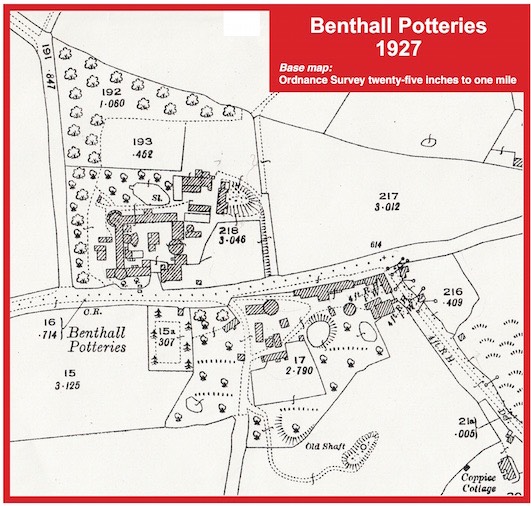
Three views of the Benthall Potteries, the bottom one dated 9 July 1939; the top two believed to be the same date.
Given the seemingly unplanned arrangement of the buildings, they may be views of the Haybrook Pottery, which was directly opposite the Benthall Pottery Co.
In the top view, the central building is in use as a hay barn, and to the extreme right is a conical kiln. The same kiln is seen in the middle view, with two unidentified men standing at the entrance gates.
The bottom image shows a kiln, with an attached building used for storing saggars (seen stacked inside, and smashed on the ground outside).
Images: © Shropshire Archives (PH/B/65; PH/B/63; PH/B/66)
Benthall Pottery Company – the later years
William Beriah Allen died in 1922, bringing to an end 60 years of Allen family involvement with the Benthall Pottery Company.
The following year, 1923, his widow, Mary, sold the business to Donald Prestage (1863–1930), a local roofing tile manufacturer and owner of the Prestage and Broseley Tileries Ltd. A small amount of Salopian Art Pottery continued to be produced under his management.
After six years, the company changed hands once again when, on 10 May 1929, Donald Prestage sold the business for £3,000 to Jack Raleigh (1887–1971), an insurance broker from Madeley. The sale documents record that the business was incorporated on 13 June 1929 as the "Benthall and Ironbridge Pottery Company Ltd.”.
It was during Raleigh's tenure as owner that an undated (c.1930) trade catalogue was published, the only one known to have been produced in the company’s long history.
The catalogue shows the company's range of domestic earthenware – tea pots, casserole dishes, baking dishes, pancheons, flower pots, bread pans, and so on. These pieces were the stock-in-trade of a traditional country pottery manufacturer, and for the 1930s some appear old-fashioned. Perhaps the catalogue was a last attempt at reviving what was otherwise a declining business.
By the 1930s, the fashion for decorative art pottery had run its course, and the last pieces of Salopian Art Pottery emerged from the kiln during this decade. A few examples of different shapes are shown on a single page in the company’s trade catalogue. The pieces are identified by shape numbers, and these are to be found scratched onto the bases of pieces.
A footnote in the catalogue says “Bazaar lots supplied”. The company had a long history of selling its Salopian Art Pottery to bazaars, beginning as early as the 1880s, as evidenced by frequent advertisements in newspapers from across Britain, but by the 1930s the business was in decline.
An Extraordinary General Meeting was held on 28 April 1930 and a resolution was passed allowing money to be borrowed against the mortgage value of the company’s property.
A cash-sale invoice of 4 April 1934, signed by Jack Raleigh, records a sale of tableware (see image, above right). Five months later, the Benthall and Ironbridge Pottery Company Ltd. was dissolved, on 18 September 1934 (as announced in The London Gazette).
Dissolving a company effectively closes it down. It ceases trading and its assets and liabilities are dealt with. This process should have happened at Benthall, but an article in the Wellington Journal & Shrewsbury News, 20 February 1937, reported that production of coronation mugs and beakers was underway at Benthall Pottery (these would be for the coronation of King George VI, 12 May 1937).
Two years later, the Shrewsbury Chronicle reported the end of Benthall Pottery’s hand-made pieces, saying:
New Industry for Broseley
This week has seen in Broseley the death of a 200-year-old industry and the birth of a new one.
The Benthall Pottery works, which virtually came to an end a year ago, after its hand-made products failed to stand up to the competition of the machine, has succumbed, and in its place and in the same workshops the Glazed Products (Midland) Ltd are beginning the manufacture of sanitary goods.
For several weeks past kilns have been built and the workshops have been adapted for the new industry.
This reorganisation work is not complete, but the new manufacture has begun and the first consignments of sanitary products left on Tuesday by motor lorry for the south of England.
The clay that was used in the pottery will still be used. It is the famous Benthall clay, produced only a short distance from the factory.
The Benthall potteries were renowned for quality of workmanship and their products may be found in many important houses. For years the market has been difficult, though not long over a year ago there were 40 employees.
Shrewsbury Chronicle, 17 February 1939, p7
This would appear to be the company known locally as “Raleigh’s Pipes”, after its owner, Jack Raleigh. The company is reported to have gone into liquidation c.1954 (Shropshire Star, 26 January 2008).
At some time after this, the manufacture of drainpipes was resumed. The final clay-based business to operate on the site closed in 1987, bringing to an end 250 years of ceramic manufacture.
The Benthall Pottery site today
Today, the site of the Benthall Pottery Company is occupied by agricultural buildings.
Only one of the company’s original buildings survives – a private house known at the time of the company as the White House. It was occupied by the company owner William Beriah Allen and, from c.1925, by the manager Percy Hartshorne (1883–1950).
On the opposite side of the road, all traces of the Haybrook Pottery have disappeared. The last of the buildings was demolished c.1960 and the site was then given over to opencast mining.
An archaeological watching brief was conducted by the Shropshire Archaeology Service in March 1998, in advance of pipe-laying for a water main. Large mounds of pottery waste were recorded in the field to the west of Benthall Pottery, alongside The Avenue.
Selected sources
John Randall 1877: “The Clay Industries including the Fictile & Ceramic Arts on the Banks of the River Severn: with notices of the early use of Shropshire clays, the history of pottery, porcelain, &c., in the district” (Madeley, Shropshire, 1877)
John Randall 1879: "Broseley and its surroundings being a complete history of Broseley, Willey, Barrow, Benthall and Linley, with notices of remarkable events, facts, phenomena and manufactures” (Salopian and West-Midland Journal, 1879)
Exhibition catalogue: International Health Exhibition, London, 1884, recording work by Francis Gibbons and Owen Gibbons, Henry Williams, students of the Coalbrookdale School of Art, Benthall Pottery Co., Maw & Co., and Craven Dunnill
Agreement between Donald Prestage and Jack Raleigh for the sale of the Benthall Pottery Company, 10 May 1929 (Shropshire Archives, 1681/190/10)
Extraordinary General Meeting resolution for the raising of money against the mortgage value of the company’s property, 28 April 1930 (Shropshire Archives, 1681/190/18)
Benthall and Ironbridge Pottery Company Ltd. dissolved: London Gazette 18 September 1934
Shropshire County Council Archaeology Service Reports 1998: A Watching Brief on the Broseley to Much Wenlock Rural Mains Pipeline
Beryl Brown: The Thursfield Family – Potters, Surgeons and Land Agents (Broseley Local History Society)
Roger Edmundson: "Benthall Pottery, Shropshire, and its Salopian Art Pottery” (Journal of the Northern Ceramic Society, vol 19, 2000
